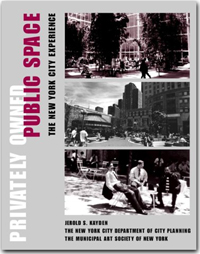Privately Owned Public Space: The New York City Experience
 As cities around the world seek new ways to improve their physical, social, and economic environments, they are paying greater attention to the value of public space. Provision of new plazas and parks, reclamation of existing waterfronts, and beautification of public streets are all increasingly viewed as important strategies for enhancing the quality of urban living. With scarce public dollars available, cities are teaming with the private sector in innovative public-private partnerships to fund these approaches.
As cities around the world seek new ways to improve their physical, social, and economic environments, they are paying greater attention to the value of public space. Provision of new plazas and parks, reclamation of existing waterfronts, and beautification of public streets are all increasingly viewed as important strategies for enhancing the quality of urban living. With scarce public dollars available, cities are teaming with the private sector in innovative public-private partnerships to fund these approaches.
One of the most significant public-private partnerships to obtain urban public space has been pioneered in New York City under the rubric of privately owned public space. Since 1961, hundreds of office and residential towers have received zoning floor area bonuses to encourage the provision of a wide variety of outdoor and indoor spaces—plazas, arcades, atriums—that are legally required to be open and accessible to the public. At their best, these spaces marry aesthetics with function, offering unique physical and social environments within a densely packed urban center. At their worst, they are barren, unusable surfaces or privatized-by-management spaces that diminish the spirit underlying the laws that created them.
Until now, comprehensive, systematic knowledge about this vast collection of public spaces has not existed, either for experts or members of the public. To remedy this gap, Harvard University professor Jerold S. Kayden, The New York City Department of City Planning, and The Municipal Art Society of New York have joined forces to research and write Privately Owned Public Space: The New York City Experience. Through words, photographs, scaled site plans, maps, and analysis of newly assembled data, they examine the history, law, design, and use of the city’s privately owned public spaces. Each of the more than 500 spaces is individually discussed to provide far-reaching comparative information about this unique category of public space.
In reading this book, designers, planners, lawyers, and academics will gain greater understanding about the possibilities and problems inherent in the design, management, and enforcement of privately owned public space. Public officials, private owners and civic group representatives will learn more about their roles in ensuring public access and vitality of such spaces. Individuals will discover where New York City’s public spaces are located and what amenities they offer. Everyone will comprehend more completely the contribution that privately owned public space can make toward open and attractive cities in which all individuals have access to a diversity of public places.
John Wiley & Sons, Inc., 2000